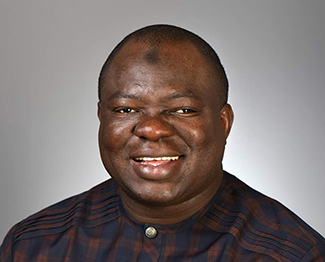Defining the genetics behind cleft palate: Q&A with Azeez Butali, PhD
July/August 2024 | Volume 23 Number 4
 Photos courtesy of the University of Iowa
Dr. Azeez Butali
Photos courtesy of the University of Iowa
Dr. Azeez Butali
Dr. Azeez Butali is a professor at the College of Dentistry, University of Iowa. After graduating as a dentist from the University of Lagos in 2000, he obtained a PhD in genetic epidemiology in 2010 and completed his postdoctoral training in craniofacial genetics at the University of Iowa. In 2014 he received an NIH Pathway to Independence Award from the National Institute of Dental and Craniofacial Research (NIDCR) to study nonsyndromic clefts in populations of African descent. Today he continues this research as principal investigator at the University of Iowa.
What led you to oral health research, specifically in a global setting?
During my first dentistry internship at the General Hospital in Lagos, Nigeria, the first child I prepared for surgery had a cleft lip and palate. I became very close to that child and their family, which sparked my interest in the causes of cleft lip and palate. While considering my postgraduate studies, I discovered a program at the University of Dundee in Scotland, a WHO Collaborating Center for Congenital Anomalies in Oral Health which aligned perfectly with my interests. There I focused on the contribution of maternal and environmental factors to cleft lip and palate. Shortly after I transitioned into my PhD where my mentor, Professor Peter Mossey, encouraged me to establish a similar research center in Africa. Recently I ran into that first child I treated for cleft lip and palate again in Nigeria. Now a young man, he expressed to me how happy he was that I had continued to dedicate my career to cleft research and told me about the impact that surgery had on his quality of life.
Tell us about the research infrastructure you set up in Nigeria.
As a PhD student, I set up eleven research centers across Nigeria to collect data and samples from individuals with cleft lip and palate. I trained clinicians to collect DNA samples for genetic analysis, with the plan to send these samples to the University of Iowa, where Professor Jeff Murray, a leading expert in cleft genetics, would analyze them for mutations that could potentially cause clef. I was later invited to Iowa as a visiting scholar where I discovered the first genetic variant for nonsyndromic clefting (a birth defect that occurs when the oral and nasal cavities don't fully divide, but there are no other abnormalities) in an African population. Professor Murray then offered me a postdoctoral position, which I accepted after completing my PhD. During my postdoc, I worked on replicating findings from that first study where I focused on abnormalities in two genes, PAX7 and VAX1, both critical for the normal development of facial features in the early stages of human growth and confirmed their involvement in clefting using samples from Asian and European populations.
Later, through funding from NIDCR, I expanded my research to Ghana and Ethiopia, allowing me and my colleagues to collect over 3,000 samples of the first genome-wide association study (GWAS) for cleft lip and palate in an African population.
 Photo credit: Agbari Multimedia/A. MaxwellButali was one of the organizers of a PhotoVoice exhibition at the University of Lagos Teaching Hospital (LUTH) in Lagos , Nigeria. Photos and text by caregivers of children with cleft lips and palate were on display.
Photo credit: Agbari Multimedia/A. MaxwellButali was one of the organizers of a PhotoVoice exhibition at the University of Lagos Teaching Hospital (LUTH) in Lagos , Nigeria. Photos and text by caregivers of children with cleft lips and palate were on display.
How did you involve the community in your research and address ethical concerns?
Following the expansion to Ghana and Ethiopia, we began to explore the ethical, legal, and social implications of our genomic studies. Our findings revealed that a little more than 2% of our cohort had actionable incidental findings, but only two percent of clinicians had the knowledge to return these results to participants.
Interestingly, most patients wanted their results back, often intending to consult community leaders, religious figures, or others outside the health care system, which told us that we needed to engage with these community gatekeepers, providing them with the necessary education and training to support patients.
This is when we started to understand that many caregivers of children with cleft lip and palate experience significant mental health challenges. To better understand and address these caregivers' needs, we employed a study design called PhotoVoice. Caregivers took photographs representing their experiences, which they then shared and discussed with us. This method yielded deep insights into their daily struggles and coping mechanisms. For example, one caregiver took a photo of children fighting, which symbolized the domestic violence she faced. Another photographed a graveyard, expressing her suicidal thoughts. These powerful images helped us understand the profound impact of clefting on caregivers’ mental health.
What are the future directions of your research?
Currently we are preparing to share our data on incidental genomic findings, the readiness of health care providers to return genetic results, and the willingness of patients to receive these results. We also plan to publish our mental health study results to inform better support systems for caregivers.
We’re also organizing a photo exhibition in Lagos, as a part of the PhotoVoice project. We hope this exhibition fosters a deeper understanding of the experiences of caregivers of children with cleft lips and palate. We’re hopeful we can also create peer mentoring groups where caregivers with positive experiences can support those facing challenges. By supporting caregivers and addressing their mental health needs, we can enhance the overall well-being of both caregivers and their children.
More Information
Updated August 15, 2024
To view Adobe PDF files,
download current, free accessible plug-ins from Adobe's website.
Related World Regions / Countries
Related Global Health Research Topics